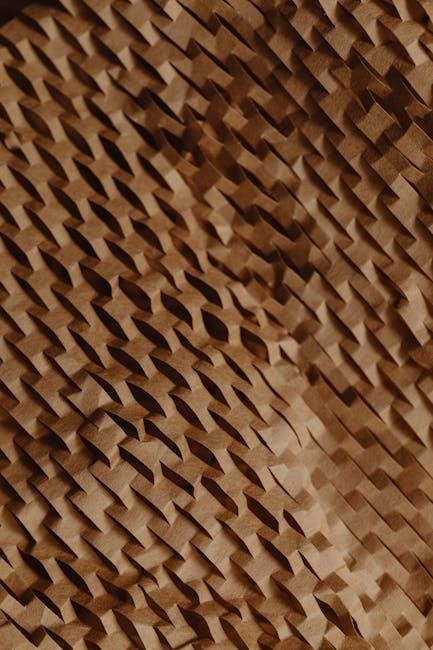This section provides a comprehensive resource for understanding prokaryotic and eukaryotic cells. It includes worksheets in PDF format, designed to assess knowledge of cell structures, functions, and differences, along with detailed answer keys.

Cells, the fundamental units of life, are broadly classified into prokaryotic and eukaryotic. Prokaryotic cells, simpler in structure, lack a nucleus and other membrane-bound organelles. Bacteria and archaea are examples of prokaryotes. Eukaryotic cells, more complex, possess a nucleus and organelles like mitochondria and endoplasmic reticulum. Plants, animals, fungi, and protists are composed of eukaryotic cells. Understanding the differences and similarities between these cell types is crucial in biology. This section introduces the basic characteristics of each cell type, laying the groundwork for more in-depth comparisons and activities.
Key Differences Between Prokaryotic and Eukaryotic Cells
Prokaryotic and eukaryotic cells exhibit several fundamental differences. Eukaryotic cells contain a membrane-bound nucleus, housing their DNA, while prokaryotic cells lack a nucleus, with their DNA residing in the cytoplasm. Eukaryotic cells are typically larger and more complex than prokaryotic cells. Prokaryotes reproduce through binary fission, whereas eukaryotes undergo mitosis or meiosis. Ribosomes also differ, with eukaryotes having 80S ribosomes and prokaryotes having 70S ribosomes. These distinctions influence the cells’ functions, structures, and overall complexity. Understanding these key differences is essential for comprehending the diversity of life at the cellular level.
Presence of a Nucleus and Membrane-Bound Organelles
A defining characteristic distinguishing eukaryotic cells from prokaryotic cells is the presence of a nucleus. Eukaryotic cells possess a well-defined nucleus, enclosed by a nuclear membrane, which houses the cell’s DNA. In contrast, prokaryotic cells lack a nucleus; their genetic material resides in the cytoplasm. Furthermore, eukaryotic cells contain various membrane-bound organelles, such as mitochondria and endoplasmic reticulum, each performing specific functions. Prokaryotic cells lack these complex internal structures. These structural differences significantly impact cellular organization, functionality, and the overall complexity of each cell type, influencing their respective roles in biological systems.
Size and Complexity of Cells
Eukaryotic cells are generally significantly larger than prokaryotic cells, typically ranging from 10 to 100 micrometers in diameter, while prokaryotic cells are typically 0.1 to 5 micrometers. This size difference reflects the increased complexity of eukaryotic cells, encompassing numerous internal structures and organelles that facilitate specialized functions. Prokaryotic cells, being smaller and simpler, possess fewer internal components and exhibit a less intricate organization. The greater size of eukaryotic cells allows for a higher degree of compartmentalization, enabling more efficient and diverse biochemical processes. This difference contributes significantly to the functional capabilities and evolutionary diversity of eukaryotic organisms.
DNA Structure and Organization

DNA structure and organization differ significantly between prokaryotic and eukaryotic cells. Eukaryotic cells house their DNA within the nucleus, organized into multiple linear chromosomes tightly wound around histone proteins. This complex structure forms chromatin, allowing for efficient packaging and regulation of gene expression. In contrast, prokaryotic cells lack a nucleus, and their DNA is typically a single, circular chromosome located in the cytoplasm within a region called the nucleoid. Prokaryotic DNA is not associated with histones to the same extent as eukaryotic DNA, and may also contain plasmids, small circular DNA molecules carrying additional genes.
Location of DNA
The location of DNA is a primary distinguishing factor between prokaryotic and eukaryotic cells. In eukaryotic cells, DNA resides within the nucleus, a membrane-bound organelle that protects the genetic material and provides a controlled environment for DNA replication and transcription. The nuclear envelope separates the DNA from the cytoplasm, ensuring proper regulation of gene expression. Conversely, prokaryotic cells lack a nucleus; their DNA is located in the cytoplasm within a region called the nucleoid. The nucleoid is not enclosed by a membrane, meaning the DNA is in direct contact with the cytoplasm and other cellular components. This difference in DNA location reflects fundamental differences in cellular organization and gene regulation between these two cell types.
Structure of DNA
The structure of DNA differs significantly between prokaryotic and eukaryotic cells. In eukaryotes, DNA exists as multiple linear chromosomes, complexed with histone proteins to form chromatin. This chromatin is further organized into tightly packed structures during cell division. Eukaryotic DNA also contains a substantial amount of non-coding DNA, including introns and regulatory sequences. In contrast, prokaryotic DNA typically consists of a single, circular chromosome located in the nucleoid region. Prokaryotic DNA contains plasmids, small circular DNA molecules that carry non-essential genes. Prokaryotic DNA has a higher proportion of coding DNA compared to eukaryotic DNA, reflecting its streamlined genome organization.
Ribosome Differences
Ribosomes, essential for protein synthesis, exhibit key differences between prokaryotic and eukaryotic cells. Eukaryotic ribosomes are larger, known as 80S ribosomes, and are composed of 40S and 60S subunits. These ribosomes are found both freely in the cytoplasm and bound to the endoplasmic reticulum. Prokaryotic ribosomes, on the other hand, are smaller, referred to as 70S ribosomes, consisting of 30S and 50S subunits. These ribosomes are located freely within the cytoplasm. The differences in ribosome structure are significant enough that some antibiotics can selectively target bacterial ribosomes, inhibiting protein synthesis in prokaryotes without affecting eukaryotic cells.

Cellular Structures and Functions
Cells, both prokaryotic and eukaryotic, possess distinct structures that perform essential functions for survival. Key components include the cytoplasm, a gel-like substance where cellular activities occur, and the plasma membrane, which encloses the cell and regulates the transport of materials. Ribosomes, found in both cell types, are responsible for protein synthesis. Eukaryotic cells contain membrane-bound organelles, such as the nucleus, mitochondria, and endoplasmic reticulum, each with specialized functions. Understanding these structures and their functions is vital for comprehending cellular processes and the differences between prokaryotic and eukaryotic cells, as highlighted in related worksheet activities.
Cytoplasm and Plasma Membranes
The cytoplasm, a vital component of both cell types, comprises the cytosol, an intracellular fluid housing organic material where most cellular activities transpire. Plasma membranes, present in both prokaryotic and eukaryotic cells, safeguard the cell and govern the transportation of substances. These membranes are selectively permeable, controlling what enters and exits the cell. Worksheets often include questions about the composition and function of these key structures, emphasizing their roles in maintaining cellular integrity and facilitating essential processes. Understanding their properties is crucial for differentiating between prokaryotic and eukaryotic cell functions.
Cell Wall and Capsule
The cell wall, offering support and protection, is a rigid outer layer found in plant cells and prokaryotic cells. However, animal cells lack this structure. Some prokaryotes possess an additional layer called a capsule, characterized by a sticky surface that allows adherence to various surfaces. Worksheets frequently address the presence, composition, and functions of cell walls and capsules, highlighting their roles in structural integrity and protection. Understanding which cell types possess these structures is essential for differentiating between prokaryotic and eukaryotic, as well as plant and animal cells.
Types of Eukaryotic Cells: Plant vs. Animal
Eukaryotic cells are diverse, primarily categorized into plant and animal cells, each with unique structural and functional characteristics. Plant cells feature a cell wall, a large vacuole, and chloroplasts for photosynthesis, while animal cells generally lack chloroplasts and cell walls, possessing only a cell membrane. Worksheets often compare and contrast these cell types, emphasizing key organelles like chloroplasts and vacuoles. Understanding these differences is essential for grasping the broader concept of eukaryotic cell specialization and adaptation to different environmental conditions and biological roles within organisms.
Plant Cell Characteristics
Plant cells possess distinct characteristics that differentiate them from other eukaryotic cells, particularly animal cells. A defining feature is the presence of a rigid cell wall composed of cellulose, providing structural support and protection. Additionally, plant cells contain chloroplasts, organelles responsible for photosynthesis, enabling them to convert light energy into chemical energy. A large central vacuole is another key characteristic, maintaining cell turgor pressure and storing water, nutrients, and waste. These unique features collectively contribute to the plant’s ability to perform photosynthesis, maintain structural integrity, and regulate cellular processes effectively.
Animal Cell Characteristics
Animal cells, unlike plant cells, lack a cell wall, relying instead on a flexible plasma membrane for structure and support. They also lack chloroplasts and are therefore incapable of photosynthesis, obtaining energy through the consumption of organic matter. Vacuoles in animal cells are typically smaller and more numerous than the large central vacuole found in plant cells. Animal cells exhibit a diverse range of specialized functions, reflected in their varied shapes, sizes, and organelle composition. These specialized cells, originating from stem cells, contribute to the complex organization and functioning of multicellular animal organisms.
Cell Division: Binary Fission vs. Mitosis/Meiosis
Cell division differs significantly between prokaryotic and eukaryotic cells. Prokaryotes reproduce via binary fission, a simpler process where the cell duplicates its genetic material and divides into two identical daughter cells. Eukaryotic cells undergo more complex processes: mitosis for growth and repair, and meiosis for sexual reproduction. Mitosis results in two daughter cells with the same chromosome number as the parent cell. Meiosis, however, produces genetically unique gametes with half the number of chromosomes, enabling genetic diversity in sexually reproducing organisms. These contrasting mechanisms highlight fundamental differences in cellular reproduction strategies.
Prokaryotic Cell Division (Binary Fission)
Binary fission is the primary method of cell division in prokaryotes, characterized by its simplicity and speed. The process begins with the replication of the single, circular chromosome. As the chromosome duplicates, the cell elongates, and the two copies move to opposite ends. Cytokinesis then occurs, where the cytoplasmic membrane invaginates, eventually dividing the cell into two identical daughter cells. Each new cell receives a complete copy of the genetic material, ensuring genetic continuity; Binary fission allows for rapid population growth in favorable conditions, contributing to the adaptability of prokaryotic organisms in diverse environments.
Eukaryotic Cell Division (Mitosis and Meiosis)
Eukaryotic cells undergo more complex division processes: mitosis and meiosis. Mitosis is for somatic cell division, producing two identical daughter cells. The process includes prophase, metaphase, anaphase, and telophase, ensuring accurate chromosome segregation. Meiosis, unique to sexually reproducing organisms, involves two rounds of division, resulting in four genetically distinct haploid gametes. During meiosis, recombination shuffles genetic material, increasing genetic diversity. These divisions maintain chromosome number during growth and repair (mitosis) and halve it for sexual reproduction (meiosis), ensuring proper genetic inheritance across generations. Precise regulation prevents errors leading to diseases.
Similarities Between Prokaryotic and Eukaryotic Cells
Despite significant differences, prokaryotic and eukaryotic cells share fundamental characteristics reflecting their common ancestry. Both cell types possess a plasma membrane, acting as a selective barrier, regulating the passage of substances in and out. They both contain cytoplasm, the gel-like substance filling the cell, housing cellular components. Furthermore, ribosomes, essential for protein synthesis, are present in both, though differing in structure. DNA, the genetic material, is found in both cell types, albeit organized differently. These shared components highlight the basic requirements for life, underlining the evolutionary connection between these two fundamental cell types, performing core functions essential for survival.
Shared Cellular Components
Prokaryotic and eukaryotic cells, despite their differences, exhibit crucial commonalities in their fundamental components. Both cell types invariably possess a plasma membrane, a selective barrier that regulates the movement of substances in and out of the cell, ensuring cellular integrity. The cytoplasm, comprising cytosol, houses the cell’s internal components and facilitates cellular activities in both types. Furthermore, both contain ribosomes, which are vital for protein synthesis. Finally, both cells contain DNA, the genetic material, which carries the instructions for cellular functions and heredity, although its organization and location differ significantly between prokaryotes and eukaryotes.
Worksheet Activities and Answer Keys

This section focuses on the practical application of knowledge regarding prokaryotic and eukaryotic cells through various worksheet activities. These activities are designed to reinforce understanding of key concepts, differences, and similarities between these cell types. The worksheets include diverse question formats such as multiple choice, true/false, fill-in-the-blank, and comparative analyses to cater to different learning styles. To facilitate effective learning and assessment, comprehensive answer keys are provided, enabling students to check their understanding and instructors to efficiently evaluate student progress. The availability of these resources supports a thorough exploration of cellular biology.
Types of Worksheet Questions
Worksheets designed to assess understanding of prokaryotic and eukaryotic cells incorporate a variety of question types to comprehensively evaluate knowledge. These include multiple-choice questions that test recognition of specific cellular structures and functions, true or false statements that assess comprehension of key concepts, and fill-in-the-blank exercises that reinforce vocabulary and definitions. Additionally, comparison charts may be used to highlight the similarities and differences between prokaryotic and eukaryotic cells. Diagram labeling activities help students identify cellular components, while short-answer questions encourage critical thinking and synthesis of information. These diverse question formats cater to different learning styles.
Availability of Answer Keys
To facilitate effective learning and assessment, answer keys for prokaryotic and eukaryotic cell worksheets are readily available. These keys provide comprehensive solutions to all questions, enabling students to check their understanding and identify areas requiring further study. Teachers can use answer keys to efficiently grade assignments and provide targeted feedback. The availability of answer keys promotes self-directed learning, allowing students to independently review material and reinforce their knowledge of cellular structures, functions, and differences between prokaryotic and eukaryotic cells. Answer keys often include detailed explanations, enhancing the learning experience. Both teachers and students benefit from readily accessible answer keys.
